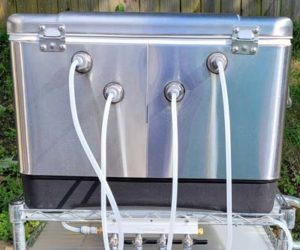The Trap Door Keezer

I wanted something that would integrate into my bar and hold at least 3 corny kegs. The keezer (kegerator + chest freezer) option was the way I decided to go. Many keezer builds utilize a wooden collar with taps mounted through the collar. Having taps sticking out the front of the keezer would be in the way so a keezer with a tap tower was the next logical step. However, one big con of fixed towers is having to pull the keezer away from the wall when lifting the lid because the tap tower will hit the wall. My solution was to build a keezer with a fixed tap tower and section in the rear with a removable lid in front.
I found a 7.1-cu. ft. (0.2-cu. m) chest freezer on sale that would hold three 5-gallon (19-L) corny kegs. If a future fourth keg is wanted, a 2.5-gallon (9.5-L) keg will fit on the internal compressor shelf. I had some 2-in. (5-cm) thick boards available, milled from trees taken down when we built our house, and I used those to make the top. As an option, you could use any 2-in. (5-cm) wide lumber or plywood sub-deck with a zinc sheeting or a tile surface could be used. But one key with this build is that the front section shouldn’t be too heavy. This section lifts off for access to the inside of the keezer. I attached an apron to the top sections that keeps the two top sections aligned. I installed a pull-type latch on each side of the apron sections to help keep the sections tight and flush. The front “trap door” section is only attached to the fixed rear section via the apron with the two pull-type latches. The bottom of each section is insulated with XPS foam board that I had lying around. The tower box is made from leftover cherry wood with an oak front and rear. As an add-on, I slipped a piece of hard copper pipe inside each pipe riser and ran one beer line through each. I insulated the insides of the tower box, and the first pour does not take too long to run cold.
I made my tower box big enough for a fourth tap if I ever wanted that option, but I chose to use that space to mount my temperature controller. I use the 4th port in my CO2 manifold for purging kegs before filling. Cheers!
Material List
Chest freezer
Wood for the top (freezer size dependent)
¼-in. x 1-in. (6-mm x 2.5-cm) foam weatherstripping
½-in. (13-mm) XPS foam board
(2) pull-action latch clamps
1-in. x 3-in. (2.5-cm x 8-cm) wood for apron
1-in. x 6-in. x 4-ft. (2.5-cm x 15-cm x 1.2-m) wood for tower box
¼-in. x 6-in. x 3-ft. (6-mm x 15-cm x 91-cm) wood for front and rear tower box covers
(2) 1¼-in. x 10-in. (3-cm x 25-cm) black iron pipe nipples
(4) 1¼-in. (3-cm) floor flanges
Temperature controller (STC-1000, UNI-STAT, or Inkbird)
Kegging setup (including 3 taps and a 4-port manifold)
Miscellaneous screws, glue, electrical box, wiring



